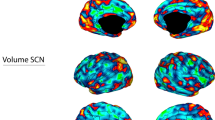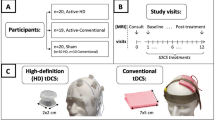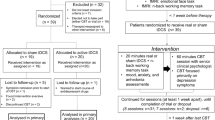Abstract
Impaired neural plasticity may be a core pathophysiological process underlying the symptomatology of schizophrenia. Plasticity-enhancing interventions, including repetitive transcranial magnetic stimulation (rTMS), may improve difficult-to-treat symptoms; however, efficacy in large clinical trials appears limited. The high variability of rTMS-related treatment response may be related to a comparably large variation in the ability to generate plastic neural changes. The aim of the present study was to determine whether negative symptom improvement in schizophrenia patients receiving rTMS to the left dorsolateral prefrontal cortex (DLPFC) was related to rTMS-related brain volume changes. A total of 73 schizophrenia patients with predominant negative symptoms were randomized to an active (n=34) or sham (n=39) 10-Hz rTMS intervention applied 5 days per week for 3 weeks to the left DLPFC. Local brain volume changes measured by deformation-based morphometry were correlated with changes in negative symptom severity using a repeated-measures analysis of covariance design. Volume gains in the left hippocampal, parahippocampal and precuneal cortices predicted negative symptom improvement in the active rTMS group (all r⩽−0.441, all P⩽0.009), but not the sham rTMS group (all r⩽0.211, all P⩾0.198). Further analyses comparing negative symptom responders (⩾20% improvement) and non-responders supported the primary analysis, again only in the active rTMS group (F(9, 207)=2.72, P=0.005, partial η 2=0.106). Heterogeneity in clinical response of negative symptoms in schizophrenia to prefrontal high-frequency rTMS may be related to variability in capacity for structural plasticity, particularly in the left hippocampal region and the precuneus.
This is a preview of subscription content, access via your institution
Access options
Subscribe to this journal
Receive 12 print issues and online access
$259.00 per year
only $21.58 per issue
Buy this article
- Purchase on Springer Link
- Instant access to full article PDF
Prices may be subject to local taxes which are calculated during checkout

Similar content being viewed by others
References
Crabtree GW, Gogos JA . Synaptic plasticity, neural circuits, and the emerging role of altered short-term information processing in schizophrenia. Front Synaptic Neurosci 2014; 6: 28.
Schizophrenia Working Group of the Psychiatric Genomics C. Biological insights from 108 schizophrenia-associated genetic loci. Nature 2014; 511: 421–427.
Hasan A, Wobrock T, Rajji T, Malchow B, Daskalakis ZJ . Modulating neural plasticity with non-invasive brain stimulation in schizophrenia. Eur ArchPsychiatrClin Neurosci 2013; 263: 621–631.
Ford JM, Mathalon DH . Neural synchrony in schizophrenia. Schizophr Bull 2008; 34: 904–906.
Rolls ET, Loh M, Deco G, Winterer G . Computational models of schizophrenia and dopamine modulation in the prefrontal cortex. Nat Rev Neurosci 2008; 9: 696–709.
van Erp TG, Hibar DP, Rasmussen JM, Glahn DC, Pearlson GD, Andreassen OA et al. Subcortical brain volume abnormalities in 2028 individuals with schizophrenia and 2540 healthy controls via the ENIGMA consortium. Mol Psychiatry 2016; 21: 547–553.
Haijma SV, Van Haren N, Cahn W, Koolschijn PC, Hulshoff Pol HE, Kahn RS . Brain volumes in schizophrenia: a meta-analysis in over 18 000 subjects. Schizophr Bull 2013; 39: 1129–1138.
Vita A, De Peri L, Deste G, Sacchetti E . Progressive loss of cortical gray matter in schizophrenia: a meta-analysis and meta-regression of longitudinal MRI studies. Transl Psychiatry 2012; 2: e190.
Meyer-Lindenberg A, Tost H . Neuroimaging and plasticity in schizophrenia. Restor Neurol Neurosci 2014; 32: 119–127.
Pajonk FG, Wobrock T, Gruber O, Scherk H, Berner D, Kaizl I et al. Hippocampal plasticity in response to exercise in schizophrenia. Arch Gen Psychiatry 2010; 67: 133–143.
Eack SM, Hogarty GE, Cho RY, Prasad KM, Greenwald DP, Hogarty SS et al. Neuroprotective effects of cognitive enhancement therapy against gray matter loss in early schizophrenia: results from a 2-year randomized controlled trial. Arch Gen Psychiatry 2010; 67: 674–682.
Ridding MC, Rothwell JC . Is there a future for therapeutic use of transcranial magnetic stimulation? Nat Rev Neurosci 2007; 8: 559–567.
Ziemann U, Paulus W, Nitsche MA, Pascual-Leone A, Byblow WD, Berardelli A et al. Consensus: Motor cortex plasticity protocols. Brain Stim 2008; 1: 164–182.
Funke K, Benali A . Modulation of cortical inhibition by rTMS - findings obtained from animal models. J Physiol 2011; 589 (Pt 18): 4423–4435.
Vlachos A, Muller-Dahlhaus F, Rosskopp J, Lenz M, Ziemann U, Deller T . Repetitive magnetic stimulation induces functional and structural plasticity of excitatory postsynapses in mouse organotypic hippocampal slice cultures. J Neurosci 2012; 32: 17514–17523.
Wang HY, Crupi D, Liu J, Stucky A, Cruciata G, Di Rocco A et al. Repetitive transcranial magnetic stimulation enhances BDNF-TrkB signaling in both brain and lymphocyte. J Neurosci 2011; 31: 11044–11054.
Ziemann U, Hallett M, Cohen LG . Mechanisms of deafferentation-induced plasticity in human motor cortex. J Neurosci 1998; 18: 7000–7007.
Huang YZ, Chen RS, Rothwell JC, Wen HY . The after-effect of human theta burst stimulation is NMDA receptor dependent. Clin Neurophysiol 2007; 118: 1028–1032.
Lefaucheur JP, Andre-Obadia N, Antal A, Ayache SS, Baeken C, Benninger DH et al. Evidence-based guidelines on the therapeutic use of repetitive transcranial magnetic stimulation (rTMS). Clin Neurophysiol 2014; 125: 2150–2206.
Lefaucheur JP, Andre-Obadia N, Antal A, Ayache SS, Baeken C, Benninger DH et al. Evidence-based guidelines on the therapeutic use of repetitive transcranial magnetic stimulation (rTMS). Clin Neurophysiol 2014; 125: 2150–2206.
Wobrock T, Guse B, Cordes J, Wolwer W, Winterer G, Gaebel W et al. Left prefrontal high-frequency repetitive transcranial magnetic stimulation for the treatment of schizophrenia with predominant negative symptoms: a sham-controlled, randomized multicenter trial. Biol Psychiatry 2015; 77: 979–988.
Hasan A, Guse B, Cordes J, Wolwer W, Winterer G, Gaebel W et al. Cognitive effects of high-frequency rTMS in schizophrenia patients with predominant negative symptoms: results from a multicenter randomized sham-controlled trial. Schizophr Bull 2016; 42: 608–618.
Nahas Z, Lomarev M, Roberts DR, Shastri A, Lorberbaum JP, Teneback C et al. Unilateral left prefrontal transcranial magnetic stimulation (TMS) produces intensity-dependent bilateral effects as measured by interleaved BOLD fMRI. Biol Psychiatry 2001; 50: 712–720.
Speer AM, Kimbrell TA, Wassermann EM, DR J, Willis MW, Herscovitch P et al. Opposite effects of high and low frequency rTMS on regional brain activity in depressed patients. Biol Psychiatry 2000; 48: 1133–1141.
Speer AM, Willis MW, Herscovitch P, Daube-Witherspoon M, Shelton JR, Benson BE et al. Intensity-dependent regional cerebral blood flow during 1- Hz repetitive transcranial magnetic stimulation (rTMS) in healthy volunteers studied with H215O positron emission tomography: II. Effects of prefrontal cortex rTMS. Biol Psychiatry 2003; 54: 826–832.
Koutsouleris N, Gaser C, Bottlender R, Davatzikos C, Decker P, Jager M et al. Use of neuroanatomical pattern regression to predict the structural brain dynamics of vulnerability and transition to psychosis. Schizophr Res 2010; 123: 175–187.
Chetelat G, Landeau B, Eustache F, Mezenge F, Viader F, de la Sayette V et al. Using voxel-based morphometry to map the structural changes associated with rapid conversion in MCI: a longitudinal MRI study. Neuroimage 2005; 27: 934–946.
Whitford TJ, Grieve SM, Farrow TF, Gomes L, Brennan J, Harris AW et al. Progressive grey matter atrophy over the first 2-3 years of illness in first-episode schizophrenia: a tensor-based morphometry study. Neuroimage 2006; 32: 511–519.
McKechanie AG, Moorhead TW, Stanfield AC, Whalley HC, Johnstone EC, Lawrie SM et al. Negative symptoms and longitudinal grey matter tissue loss in adolescents at risk of psychosis: preliminary findings from a 6-year follow-up study. Br J Psychiatry 2015; 208: 565–570.
Kipps CM, Duggins AJ, Mahant N, Gomes L, Ashburner J, McCusker EA . Progression of structural neuropathology in preclinical Huntington's disease: a tensor based morphometry study. J Neurol Neurosurg Psychiatry 2005; 76: 650–655.
Voxel-Based Morphometry Toolbox, version 8 (VBM8). Available at: http://dbm.neuro.uni-jena.de (Accessed January 4th 2016, Release date August 22nd 2011 - Version 425).
Ashburner J . A fast diffeomorphic image registration algorithm. Neuroimage 2007; 38: 95–113.
Klein A, Andersson J, Ardekani BA, Ashburner J, Avants B, Chiang MC et al. Evaluation of 14 nonlinear deformation algorithms applied to human brain MRI registration. Neuroimage 2009; 46: 786–802.
Dyrba M, Ewers M, Wegrzyn M, Kilimann I, Plant C, Oswald A et al. Robust automated detection of microstructural white matter degeneration in Alzheimer's disease using machine learning classification of multicenter DTI data. PLoS One 2013; 8: e64925.
Hayasaka S, Phan KL, Liberzon I, Worsley KJ, Nichols TE . Nonstationary cluster-size inference with random field and permutation methods. Neuroimage 2004; 22: 676–687.
Tzourio-Mazoyer N, Landeau B, Papathanassiou D, Crivello F, Etard O, Delcroix N et al. Automated anatomical labeling of activations in SPM using a macroscopic anatomical parcellation of the MNI MRI single-subject brain. Neuroimage 2002; 15: 273–289.
Leucht S, Davis JM, Engel RR, Kissling W, Kane JM . Definitions of response and remission in schizophrenia: recommendations for their use and their presentation. Acta Psychiatr Scand Suppl 2009; 438: 7–14.
Beitinger R, Lin J, Kissling W, Leucht S . Comparative remission rates of schizophrenic patients using various remission criteria. Progr Neuro-psychopharmacol Biol Psychiatry 2008; 32: 1643–1651.
May A, Hajak G, Ganssbauer S, Steffens T, Langguth B, Kleinjung T et al. Structural brain alterations following 5 days of intervention: dynamic aspects of neuroplasticity. Cereb Cortex 2007; 17: 205–210.
Lehner A, Langguth B, Poeppl TB, Rupprecht R, Hajak G, Landgrebe M et al. Structural brain changes following left temporal low-frequency rTMS in patients with subjective tinnitus. Neural Plast 2014; 2014: 132058.
Nahas Z, DeBrux C, Chandler V, Lorberbaum JP, Speer AM, Molloy MA et al. Lack of significant changes on magnetic resonance scans before and after 2 weeks of daily left prefrontal repetitive transcranial magnetic stimulation for depression. J ECT 2000; 16: 380–390.
Draganski B, Gaser C, Busch V, Schuierer G, Bogdahn U, May A . Neuroplasticity: changes in grey matter induced by training. Nature 2004; 427: 311–312.
Kuhn S, Gleich T, Lorenz RC, Lindenberger U, Gallinat J, Playing Super Mario . induces structural brain plasticity: gray matter changes resulting from training with a commercial video game. Mol Psychiatry 2014; 19: 265–271.
Tang A, Thickbroom G, Rodger J . Repetitive transcranial magnetic stimulation of the brain: mechanisms from animal and experimental models. Neuroscientist 2015; 7: pii: 1073858415618897.
Ueyama E, Ukai S, Ogawa A, Yamamoto M, Kawaguchi S, Ishii R et al. Chronic repetitive transcranial magnetic stimulation increases hippocampal neurogenesis in rats. Psychiatry Clin Neurosci 2011; 65: 77–81.
Muller MB, Toschi N, Kresse AE, Post A, Keck ME . Long-term repetitive transcranial magnetic stimulation increases the expression of brain-derived neurotrophic factor and cholecystokinin mRNA, but not neuropeptide tyrosine mRNA in specific areas of rat brain. Neuropsychopharmacology 2000; 23: 205–215.
Pell GS, Roth Y, Zangen A . Modulation of cortical excitability induced by repetitive transcranial magnetic stimulation: influence of timing and geometrical parameters and underlying mechanisms. Progre Neurobiol 2011; 93: 59–98.
Abe M, Fukuyama H, Mima T . Water diffusion reveals networks that modulate multiregional morphological plasticity after repetitive brain stimulation. Proc Natl Acad Sci USA 2014; 111: 4608–4613.
Heckers S, Konradi C . Hippocampal pathology in schizophrenia. Curr Top Behav Neurosci 2010; 4: 529–553.
Sigmundsson T, Suckling J, Maier M, Williams S, Bullmore E, Greenwood K et al. Structural abnormalities in frontal, temporal, and limbic regions and interconnecting white matter tracts in schizophrenic patients with prominent negative symptoms. Am J Psychiatry 2001; 158: 234–243.
Koutsouleris N, Gaser C, Jager M, Bottlender R, Frodl T, Holzinger S et al. Structural correlates of psychopathological symptom dimensions in schizophrenia: a voxel-based morphometric study. Neuroimage 2008; 39: 1600–1612.
Bilek E, Schafer A, Ochs E, Esslinger C, Zangl M, Plichta MM et al. Application of high-frequency repetitive transcranial magnetic stimulation to the DLPFC alters human prefrontal-hippocampal functional interaction. J Neurosci 2013; 33: 7050–7056.
Miller EK, Cohen JD . An integrative theory of prefrontal cortex function. Annu Rev Neurosc 2001; 24: 167–202.
Godsil BP, Kiss JP, Spedding M, Jay TM . The hippocampal-prefrontal pathway: the weak link in psychiatric disorders? Eur Neuropsychopharmacol 2013; 23: 1165–1181.
Ghoshal A, Conn PJ . The hippocampo-prefrontal pathway: a possible therapeutic target for negative and cognitive symptoms of schizophrenia. Future Neurol 2015; 10: 115–128.
Kraguljac NV, White DM, Hadley J, Reid MA, Lahti AC . Hippocampal-parietal dysconnectivity and glutamate abnormalities in unmedicated patients with schizophrenia. Hippocampus 2014; 24: 1524–1532.
Kirkpatrick B, Buchanan RW, McKenney PD, Alphs LD, Carpenter WT Jr. . The Schedule for the Deficit syndrome: an instrument for research in schizophrenia. Psychiatry Res 1989; 30: 119–123.
Prikryl R, Kucerova HP . Can repetitive transcranial magnetic stimulation be considered effective treatment option for negative symptoms of schizophrenia? J ECT 2013; 29: 67–74.
Blumberger DM, Maller JJ, Thomson L, Mulsant BH, Rajji TK, Maher M et al. Unilateral and bilateral MRI-targeted repetitive transcranial magnetic stimulation for treatment-resistant depression: a randomized controlled study. J Psychiatry Neurosci 2016; 41: E58–E66.
Kozel FA, Nahas Z, deBrux C, Molloy M, Lorberbaum JP, Bohning D et al. How coil-cortex distance relates to age, motor threshold, and antidepressant response to repetitive transcranial magnetic stimulation. J Neuropsychiatry Clin Neurosci 2000; 12: 376–384.
Nahas Z, Teneback CC, Kozel A, Speer AM, DeBrux C, Molloy M et al. Brain effects of TMS delivered over prefrontal cortex in depressed adults: role of stimulation frequency and coil-cortex distance. J Neuropsychiatry Clin Neurosci 2001; 13: 459–470.
Nathou C, Simon G, Dollfus S, Etard O . Cortical anatomical variations and efficacy of rTMS in the treatment of auditory hallucinations. Brain Stimul 2015; 8: 1162–1167.
Acknowledgements
The RESIS trial was supported by the Deutsche Forschungsgemeinschaft Grant No. FA–210/1.
Trial Registration: http://clinicaltrials.gov/; NCT00783120.
Author information
Authors and Affiliations
Corresponding author
Ethics declarations
Competing interests
AH has been invited to scientific meetings by Lundbeck, Janssen-Cilag and Pfizer, and he received a paid speakership from Desitin, Otsuka and Lundbeck. He was member of a advisory board of Roche. TW has received paid speakerships from Alpine Biomed, AstraZeneca, Bristol–Myers–Squibb, Eli Lilly, I3G, Janssen-Cilag, Novartis, Lundbeck, Roche, Sanofi-Aventis, Otsuka and Pfizer, and has accepted travel or hospitality not related to a speaking engagement from AstraZeneca, Bristol–Myers–Squibb, Eli Lilly, Janssen-Cilag and Sanofi-Synthelabo, and has received restricted research grants from AstraZeneca, Cerbomed, I3G and AOK (health insurance company). JC was a member of an advisory board of Roche, accepted travel or hospitality not related to a speaking engagement from Servier, support for symposia from Inomed, Localite, Magventure, Roche, Mag & More, NeuroConn, Syneika, FBI Medizintechnik, Spitzer Arzneimittel and Diamedic. WW has received paid speakerships from Bristol–Myers–Squibb, Essex Pharma, Janssen-Cilag, Lilly Deutschland and Pfizer Neuroscience. He is a member of the Neuroscience Academy of Roche Pharma. WG has received symposia support from Janssen-Cilag GmbH, Neuss, Lilly Deutschland GmbH, Bad Homburg and Servier, Munich. He is a member of the Faculty of the Lundbeck International Neuroscience Foundation (LINF), Denmark. BL received honoraria and speakers’ fees from ANM, AstraZeneca, Autifony, Lundbeck, Merz, Magventure, Novartis, Pfizer and Servier, research funding from the Tinnitus Research Initiative, the German Research Foundation, the German Bundesministerium für Bildung und Forschung, the American Tinnitus Association, AstraZeneca and Cerbomed, funding for equipment from Magventure and Deymed and travel and accommodation payments from Lilly, Lundbeck, Servier and Pfizer. GH has received payments as speaker, consultant, author or for research funding during the last 5 years from Actelion, Affectis, AstraZeneca, Bayerische Motorenwerke, Bundesministerium für Bildung und Forschung, Bundesministerium für Strahlenschutz, Bristol-Meyers Squibb, Cephalon, Daimler Benz, Deutsche Forschungsgesellschaft, Elsevier, EuMeCom, Essex, Georg Thieme, Gerson Lerman Group Council of Healthcare Advisors, GlaxoSmithKline, Janssen-Cilag, Lilly, Lundbeck, Meda, Merck, Merz, Novartis, Pfizer, Proctor & Gamble, Sanofi-Aventis, Schering-Plough, Sepracor, Servier, Springer, Urban & Fischer and Volkswagen. WGH is an unpaid member of the Advisory Board of In Silico Biosciences, and a paid consultant to Otsuka/Lundbeck, Roche, Novartis, Eli Lilly, MDH Consulting and the Canadian Agency on Drugs and Technology in Health. PF was honorary speaker for Janssen-Cilag, AstraZeneca, Eli Lilly, Bristol–Myers–Squibb, Lundbeck, Pfizer, Bayer Vital, SmithKline Beecham, Wyeth and Essex. During the last 5 years, but not presently, he was a member of the advisory boards of Janssen-Cilag, AstraZeneca, Eli Lilly and Lundbeck. NK received paid speakership from Otsuka. The remaining authors declare no conflict of interest.
Additional information
Supplementary Information accompanies the paper on the Molecular Psychiatry website
Supplementary information
PowerPoint slides
Rights and permissions
About this article
Cite this article
Hasan, A., Wobrock, T., Guse, B. et al. Structural brain changes are associated with response of negative symptoms to prefrontal repetitive transcranial magnetic stimulation in patients with schizophrenia. Mol Psychiatry 22, 857–864 (2017). https://doi.org/10.1038/mp.2016.161
Received:
Revised:
Accepted:
Published:
Issue Date:
DOI: https://doi.org/10.1038/mp.2016.161
This article is cited by
-
Neuroimaging biomarkers define neurophysiological subtypes with distinct trajectories in schizophrenia
Nature Mental Health (2023)
-
Repetitive Transcranial Magnetic Stimulation as a Therapeutic and Probe in Schizophrenia: Examining the Role of Neuroimaging and Future Directions
Neurotherapeutics (2021)
-
Magnetic Resonance Imaging-Guided and Navigated Individualized Repetitive Transcranial Magnetic Stimulation for Cognitive Impairment in Schizophrenia
Neuroscience Bulletin (2021)
-
Functional near-infrared spectroscopy (fNIRS) as a tool to assist the diagnosis of major psychiatric disorders in a Chinese population
European Archives of Psychiatry and Clinical Neuroscience (2021)
-
Precise Modulation Strategies for Transcranial Magnetic Stimulation: Advances and Future Directions
Neuroscience Bulletin (2021)



